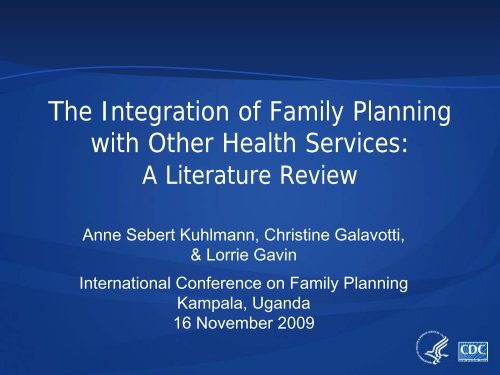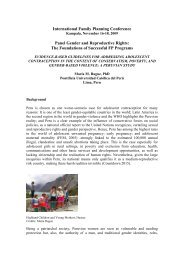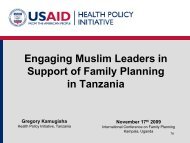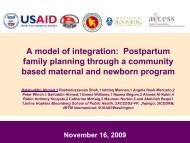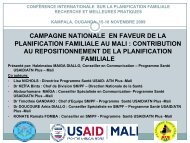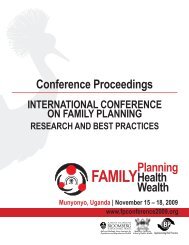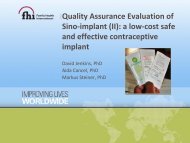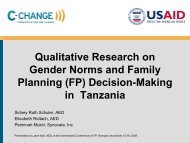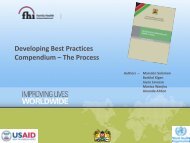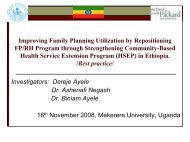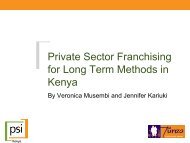The Integration of Family Planning with Other Health Services:
The Integration of Family Planning with Other Health Services:
The Integration of Family Planning with Other Health Services:
You also want an ePaper? Increase the reach of your titles
YUMPU automatically turns print PDFs into web optimized ePapers that Google loves.
<strong>The</strong> <strong>Integration</strong> <strong>of</strong> <strong>Family</strong> <strong>Planning</strong><br />
<strong>with</strong> <strong>Other</strong> <strong>Health</strong> <strong>Services</strong>:<br />
A Literature Review<br />
Anne Sebert Kuhlmann, Christine Galavotti,<br />
& Lorrie Gavin<br />
International Conference on <strong>Family</strong> <strong>Planning</strong><br />
Kampala, Uganda<br />
16 November 2009
Background<br />
• Many calls exist for integration as a way to<br />
address unmet need for family planning<br />
• But, we must establish an evidence base for the<br />
effectiveness <strong>of</strong> such an approach before<br />
investing significant resources<br />
• Previous reviews have focused on the<br />
integration <strong>of</strong> family planning <strong>with</strong> a specific type<br />
<strong>of</strong> health service
Purpose<br />
To review the literature for the current state<br />
<strong>of</strong> knowledge about the effectiveness <strong>of</strong><br />
integrating family planning services <strong>with</strong><br />
any other health services
Databases<br />
• PubMed<br />
• Embase<br />
• CABDirect<br />
• PsycINFO<br />
• Social Sciences<br />
Citation Index<br />
Search Strategy<br />
Terms<br />
• <strong>Family</strong> planning, birth<br />
spacing, birth control,<br />
contraception, pregnancy<br />
planning, OR pregnancy<br />
prevention<br />
AND<br />
• <strong>Integration</strong>, service<br />
integration, bundling OR<br />
twinning<br />
Limits<br />
• 1994-2009 (mid-year)<br />
• English
Inclusion Criteria<br />
1. Evaluation studies reporting a family<br />
planning-related outcome (i.e., contraceptive<br />
prevalence, service utilization)<br />
2. Studies using either a) single-group pre-test/<br />
post-test design or b) two-group comparison<br />
or control design
Search Results<br />
581<br />
abstracts reviewed<br />
80<br />
relevant abstracts<br />
15<br />
articles reviewed<br />
9<br />
included
6<br />
5<br />
4<br />
3<br />
2<br />
1<br />
0<br />
EPI<br />
<strong>Health</strong> <strong>Services</strong> Integrated<br />
<strong>with</strong> <strong>Family</strong> <strong>Planning</strong>*<br />
MCH<br />
Curative care<br />
HIV/STI<br />
Post-abortion care<br />
Water & sanitation<br />
Micro-credit<br />
*Some interventions integrated multiple services
6<br />
5<br />
4<br />
3<br />
2<br />
1<br />
0<br />
Intervention Type (n=9)<br />
Clinic-based Community-component
6<br />
5<br />
4<br />
3<br />
2<br />
1<br />
0<br />
Pre-test / posttest<br />
Study Design*<br />
Crosssectional<br />
w/<br />
comparison<br />
Case-control Quasiexperimental<br />
*Two evaluations combined 2 designs
<strong>Integration</strong> May Improve<br />
Service Utilization<br />
Togo: EPI referral to FP (Huntington & Apolgan 1994)<br />
Average # new FP clients Pre (1991) Post (1992) p-value<br />
• Intervention 1035 1311
<strong>Integration</strong><br />
& Service Utilization (cont.)<br />
Nigeria: Dual Protection Counseling (Adeokun et al. 2002)<br />
Pre (1999) Post (2001)<br />
• Condoms purchased at FP visit 2% 9%<br />
Niger: Integrated MCH-FP counseling (Bossyns et al. 2002)<br />
Pre (1999) Post (’99-’00)<br />
• FP proposed 5.4% 99.2%<br />
• FP accepted 79.8% 46.7%<br />
• FP supplied 20.0% 62.1%<br />
• Index - Uptake <strong>of</strong> Contraception 0.86% 28.8%
<strong>Integration</strong> May Increase<br />
Contraceptive Prevalence<br />
India: Local Initiatives Program (Paxman et al. 2005)<br />
Contraceptive prevalence Pre (1999) Post (2003)<br />
• CRRID 59% 69%<br />
• CINI 34% 59%<br />
• HIHT 27% 66%<br />
Bangladesh: FP w/ EPI & Micro-Credit (Amin et al. 2001)<br />
Pre (1992) Post (1997)<br />
• Contraceptive prevalence 28% 53%<br />
Pakistan: Lady <strong>Health</strong> Worker Program (Douthwaite & Ward 2005)<br />
• Use <strong>of</strong> modern method increased OR=1.50 (1.04-2.16)
Limitations<br />
• Focused on peer-reviewed literature<br />
• Restricted to English-language<br />
publications
Conclusions<br />
• Existing research provides some evidence<br />
suggesting benefits <strong>of</strong> integration & helps to<br />
generate hypotheses<br />
• But, well-designed, further evaluation research <strong>of</strong><br />
family planning programs integrated <strong>with</strong> other<br />
health services is still needed<br />
• Future research should report outcomes for all<br />
integrated health areas & should investigate<br />
client & community member perspectives
Thank you!
Appendix:<br />
Citations <strong>of</strong> Included Articles<br />
Adeokun, L et al. Promoting dual protection in family planning clinics<br />
in Ibadan, Nigeria. IFPP, 2002, 28, 87-95.<br />
Alvarado, R et al. Integrated maternal and infant health care in the<br />
postpartum period in a poor neighborhood in Santiago, Chile. Stud<br />
Fam Plann, 1999, 30, 133-141.<br />
Amin, R et al. <strong>Integration</strong> <strong>of</strong> an essential services package (ESP) in<br />
child and reproductive health and family planning <strong>with</strong> a micro-credit<br />
program for poor women: experience from a pilot project in rural<br />
Bangladesh. World Development, 2001, 29, 1611-1621.<br />
Bossyns, P et al. Supply-level measures to increase uptake <strong>of</strong> family<br />
planning services in Niger: the effectiveness <strong>of</strong> improving<br />
responsiveness. Tropical Medicine & International <strong>Health</strong>, 2002, 7,<br />
383-390.
Appendix (cont.)<br />
Douthwaite, M & Ward, P. Increasing contraceptive use in rural<br />
Pakistan: an evaluation <strong>of</strong> the Lady <strong>Health</strong> Worker Programme.<br />
<strong>Health</strong> Policy & <strong>Planning</strong>, 2005, 20, 117-123.<br />
Fullerton, J et al. A case/comparison study in the Eastern Region <strong>of</strong><br />
Ghana on the effects <strong>of</strong> incorporating selected reproductive health<br />
services on family planning services. Midwifery, 2003, 19, 17-26.<br />
Huntington D & Aplogan A. <strong>The</strong> integration <strong>of</strong> family planning and<br />
childhood immunization services in Togo. Stud Fam Plann. 1994<br />
25(3):176-83.<br />
Lundgren, R et al. Cultivating men's interest in family planning in rural<br />
El Salvador. Studies in <strong>Family</strong> <strong>Planning</strong>, 2005, 36, 173-188.<br />
Paxman, JM et al. <strong>The</strong> India Local Initiatives Program: A Model for<br />
Expanding Reproductive and Child <strong>Health</strong> <strong>Services</strong>. Stud Fam<br />
Plann, 2005, 36, 203-220.


